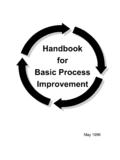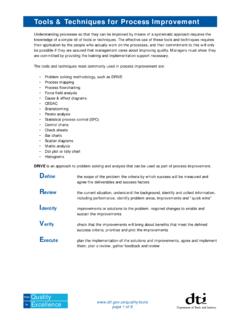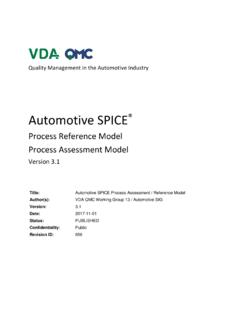Transcription of A-EQUIP - a model of clinical midwifery supervision
1 A-EQUIPa model of clinical midwifery supervisionA-EQUIP: an acronym for Advocating for Education and QUality ImProvementEqualities statementPromoting equality and addressing health inequalities are at the heart of NHS England s values. Throughout the development of the policies and processes cited in this document, we have: Given due regard to the need to eliminate discrimination, harassment and victimisation, to advance equality of opportunity, and to foster good relations between people who share a relevant protected characteristic (as cited under the Equality Act 2010) and those who do not share it; and Given regard to the need to reduce inequalities between patients in access to, and outcomes from healthcare services and to ensure services are provided in an integrated way where this might reduce health inequalitiesPublications Gateway Reference Number: 06612iContentsForeword iiiExecutive Summary ivContext and background ivA new model of midwifery supervision ivTransition from a statutory model to an employer led model vConclusion viIntroduction viiPart 1 The case for change 1 Background and context 2 Part 2 A-EQUIP a new model of supervision 3 Developing A-EQUIP 4 New model principles 4Co-production with stakeholders 4 You said we did 5 The four functions of A-EQUIP 6 clinical supervision (restorative) 7 Monitoring, evaluation and Quality Control (normative) 8 Personal action for quality improvement 9 Education and development (formative) 10 The role of the Professional midwifery Advocate (PMA)
2 11 The PMA as a leader 12 Regional support for PMAs 12 PMA to Staff ratio 12 Frequency of meetings with a PMA 13 Selection of a PMA 14 General Principles for a PMA 15 Joint responsibilities of the PMA and Midwife 16 Beginning a clinical supervision session 16 Concluding the meeting 16Do you have a question? 16iiA-EQUIP a model of clinical midwifery supervisionHow A-EQUIP and the PMA role works for women 17 Advocating for women 17 Providing direct support for women within a restorative approach 19 Undertaking personal action for quality improvement in collaboration with women 19 Part 3 Case Studies 21 Using the A-EQUIP model 21 Part 4 Guidance for Implementation 29 Introduction 30 Section 1: Guidance for providers 31 Section 2: Guidance for commissioners 33 clinical Commissioning Group Maternity Specification 34 Section 3.
3 Guidance for Higher Education Institutions 35 Education Programmes preparing PMAs 36UK Education principles 36 The PMA Preparation Programmes 37 Conclusion 39 References 40 Appendices 43 Appendix 1: Reviews and recommendations 44 Appendix 2: Membership of the supervision Task Force and Work Streams 46 Appendix 3: Key reports and published works 50 Appendix 4: Professional midwifery Advocate Job Profile 52 Appendix 5: Professional midwifery Advocate Education Programme 61 Appendix 6: Frequently Asked Questions 78 Appendix 7: Professional midwifery Advocate Competency Framework 81 Appendix 8: Evaluation of the Pilot Sites 89iiiForewordProfessor Jane Cummings, Chief Nursing Officer for EnglandAs Chief Nursing Officer for England I am immensely proud of our midwifery profession and the way midwives continue to strive to improve the maternity experiences and outcomes for women and their development and support similar to clinical supervision has been available to midwives since 1902 through statutory supervision .
4 Over recent years, the identification of failures in the provision of safe and compassionate care within maternity services (Parliamentary and Health Service Ombudsman [PHSO] 2013, Francis 2013, National Advisory Group on the Safety of Patients In England 2013, Kirkup 2015, The King s Fund 2015) has led to a fundamental change in the way midwives are regulated. This has provided an ideal opportunity for the midwifery profession to develop a new model for midwifery clinical supervision (Department of Health [DH] 2016a).As Chief Nursing Officer for England and on behalf of other senior professional leaders in England, I am launching a new model of clinical supervision for midwives that aims to facilitate a continuous improvement process that values midwives, builds their personal and professional resilience and contributes to the provision of high quality care. These aims are aligned with the ambitions of the National Maternity review: Better Births (DH 2016b), the NHS Five Year Forward View (National Health Service England [NHSE] (2014), and Leading Change Adding Value; a framework for nursing, midwifery and care staff (NHSE 2016).)
5 I would like to thank the Local Supervising Authority (LSA) national Task Force for steering the production of the new supervision model and I commend them for working in partnership with women who use maternity services, midwives, leaders and educators, to develop a model that will add value to outcomes for women and their families and the profession. I also thank the pilot sites for the contribution that they have made to testing the new model and assisting with the evaluation. The outcome of this work has had far reaching consequences for the implementation of a model of midwifery clinical supervision that invests in midwives and supports them in the provision of safe high quality care for women, babies and their families. Jane CummingsProfessor Jane Cummings, Chief Nursing Officer for EnglandDate 7 April 2017ivExecutive Summary1 The relevant sections of these reports can be found at Appendix document describes the new model of midwifery supervision , A-EQUIP , an acronym for advocating and educating for quality improvement and provides guidance for implementation.
6 It is of particular relevance to: All midwives, student midwives, members of the multi professional team, providers of maternity services, clinical Commissioning Groups (CCGs), Higher Education Institutes (HEIs), The Care Quality Commission (CQC), Maternity Service Liaison Committees (MSLC), Maternity Voices Partnership and Patient Advisory document describes the impact of the legislative change on midwifery regulation and the changes to midwifery supervision . It describes the A-EQUIP model and its benefit to midwives and service users. Case studies have been developed to show how the model can be deployed to support staff working in clinical and non- clinical roles. Key actions for midwives, maternity providers, CCGs and HEIs have been described to aid implementation. Context and background Professional development and support similar to clinical supervision has been available to midwives since 1902 through statutory supervision .
7 As a result of legislative change, the function of Local Supervising Authorities (LSA) and statutory supervision of midwifery have now been removed. This was prompted by the brave efforts of three families, who raised complaints that related to local midwifery supervision and regulation. In all three cases, the midwifery supervision and regulatory arrangements at the local level failed to identify poor midwifery practice (Parliamentary and Health Service Ombudsman [PHSO] 2013, page 2)The PHSO report and the Department of Health (DH) investigation led by Dr Bill Kirkup1 were critical of the additional tier of midwifery regulation provided by Statutory supervision of Midwives. The Nursing and midwifery Council (NMC) therefore commissioned the King s Fund to undertake an independent review of midwifery regulation. The findings of the Kings Fund review (January 2015) was broadly aligned with the findings of the PHSO report and, subsequently, the Kirkup Report (March 2015) making the recommendation that the supervision and regulation of midwives should be separated and the NMC as the regulator should be in direct control of all regulatory governing legislation (the Nursing and midwifery Order 2001) has been subject to a Section 60 order and the function of Local Supervising Authorities (LSA) and statutory supervision of midwifery have been new model of midwifery supervisionWith the sponsorship of the Chief Nursing Officer for England, a time limited Task Force2 developed a new model of midwifery clinical supervision and set out plans for the transition from a statutory model of supervision , to an employer led professional model (DH 2016a) called A-EQUIP .
8 VThe development of A-EQUIP and the associated role of the Professional midwifery Advocate (PMA)3 have been co-produced with women who use maternity services, midwives, academics, midwifery and nurse leaders and managers, commissioners, the Royal College of Midwives (RCM) and developing the new model , the Task Force agreed that Proctor s three function model of clinical supervision (Proctor 1986) and Hawkins and Shohet s (2012) adaptation of the model , closely described the functions identified by stakeholders as being important for inclusion in the A-EQUIP model . In addition to the functions of Proctor s (1986) model (formative, normative and restorative,) the A-EQUIP model includes a fourth function described as personal action for quality improvement , which indicates the importance of continuous improvement . The A-EQUIP model supports a continuous improvement process that aims to build personal and professional resilience of midwives, enhance quality of care for women and babies and support preparedness for appraisal and professional revalidation.
9 The restorative function has been shown to: have a positive impact on the immediate wellbeing of staff, helps staff to feel valued by their employers for investing in them and their wellbeing, influence a significant reduction in stress and burnout, the job satisfaction of staff, improve the retention of staff, reduce stress levels whilst maintaining compassion, improve working relationships and team dynamics, help staff to manage work/life balance more effectively and increase enjoyment and satisfaction related to work (Pettit and Stephen 2015).3 The PMA is the practitioner who will deploy the A-EQUIP model and the associated leadership role, see Appendix 4 for the job profileThe A-EQUIP model works for women in three ways: Supporting midwives to advocate for women Providing direct support for women within a restorative approach and Undertaking quality improvement in collaboration with women.
10 Transition from a statutory model to an employer led modelThe transition from the statutory model of midwifery supervision to the employer led model requires support from maternity providers, commissioners and Professional midwifery Advocates (PMAs) are prepared through a programme of education, maternity providers are required to support the non-statutory functions of the supervisor of midwives role, that should be provided within the context of the organisations management and governance support commissioners and providers to understand the commissioning requirements of the A-EQUIP model , a commissioning specification has been developed and can be found at part four of this guidance. The NHS Standard Contract 2017/18-2018/19 is mandated by NHS England for use by commissioners for all contracts for healthcare services other than primary care. In accordance with this contract, the provider must ensure that arrangements are in place for all midwives to receive the new national model of midwifery preparation of PMAs is crucial to the success of the PMA role.













